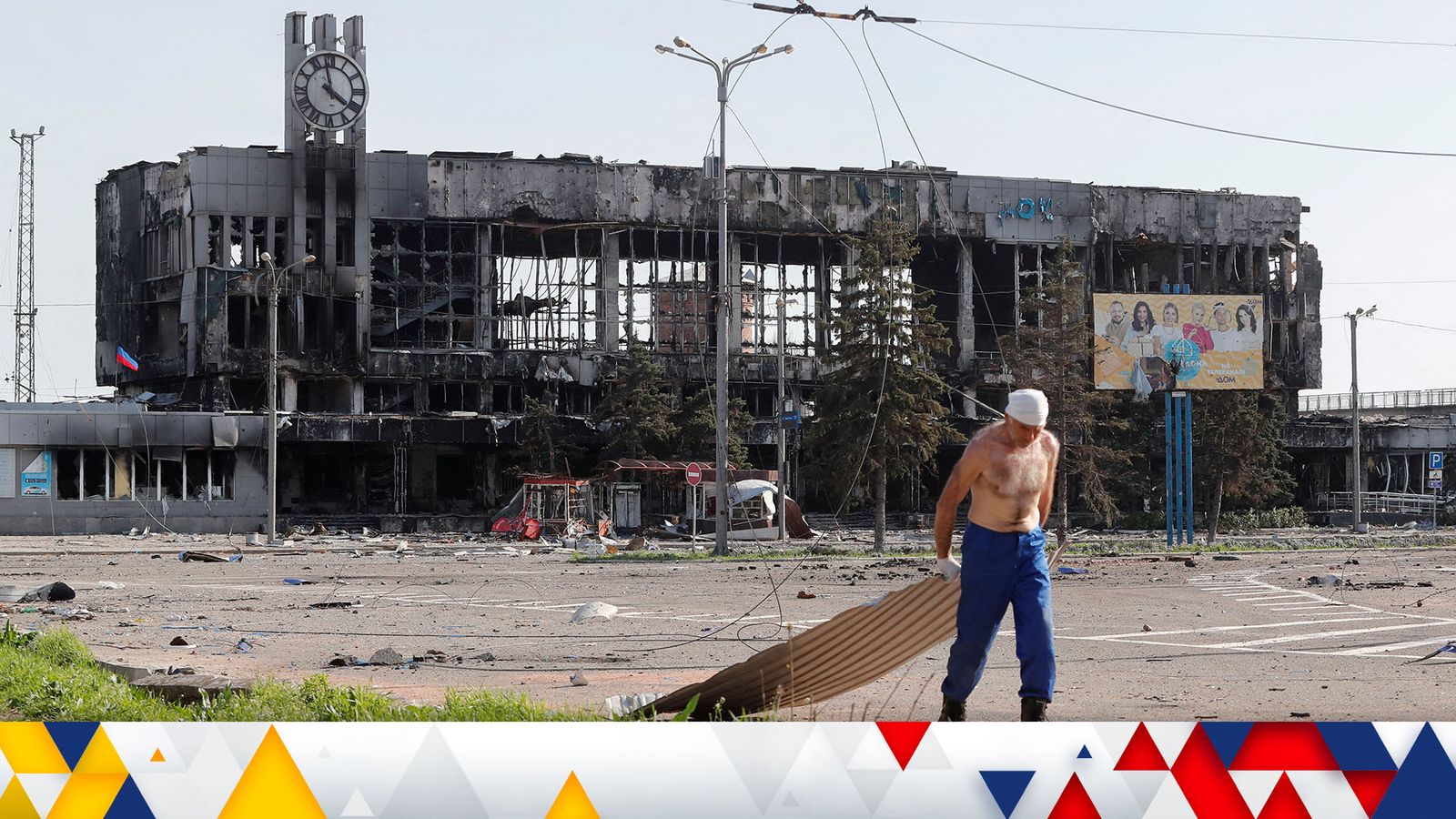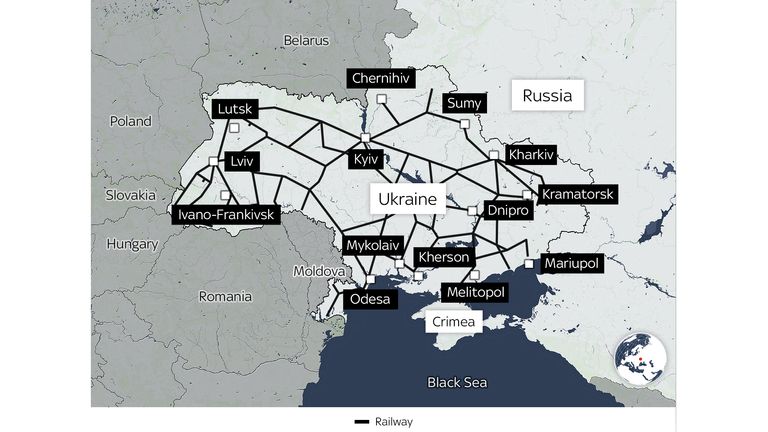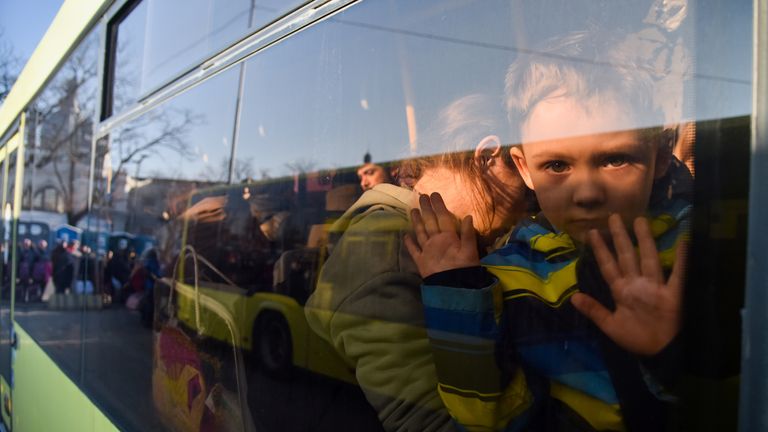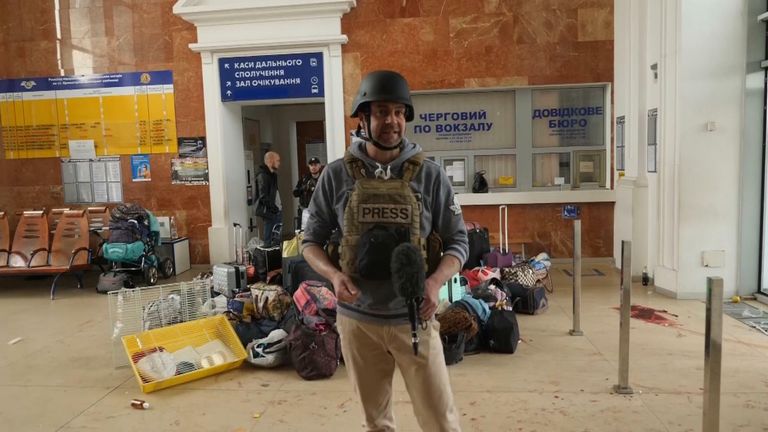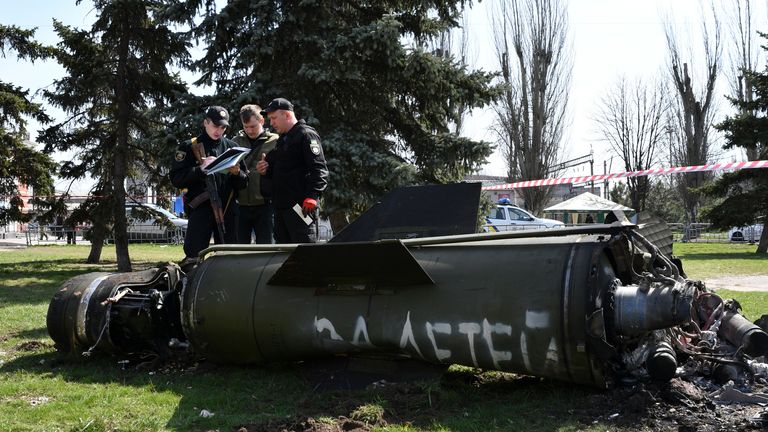Throughout the war in Ukraine, Russia has carried out consistent attacks on the country’s rail system.
Ukraine‘s state-owned railway, Ukrzaliznytsia, is the country’s largest employer with over 200,000 staff across 233,000 square miles.
During the war it has been a lifeline for millions of people who fled the country and has proved essential to Ukraine’s strategic objectives.
Russia has launched dozens of attacks on the rail infrastructure, hitting its tracks, bridges and electricity substations using a range of weapons like rockets and cruise missiles.
While many of these have only caused minor and reparable damage to the railway, the human cost is more stark with a missile attack on Kramatorsk’s train station killing dozens of civilians who were trying to flee.
And it is not just people who are being transported.
The vast railway network has been used to supply key Western arms shipments which have helped Ukrainian forces defend territory from Russia’s initial offensive and have helped transport grain.
Damage so far only ‘disrupts and delays’
Ukrainian officials say Russia aims to destroy the country’s infrastructure – while the Russian defence ministry has admitted that its rail attacks are aimed at disrupting the flow of Western weapons.
Experts say that if Russia’s objective is to paralyse the supply of Western weapons, it has so far failed.
Defence and intelligence experts say attacks on the railway have largely been seen as “disruptive”, but haven’t caused significant and lasting damage.
They point to two main reasons why its forces have failed to effectively damage the railway – the Ukrainian force’s ability to repair damage and difficulties hitting moving targets.
Russia has ‘difficulty’ hitting moving targets
Ed Arnold, European Security Research Fellow at The Royal United Services Institute, told Sky News that Russia faces difficulty hitting moving targets due to its weapon capabilities.
“Russian attacks are unable to deliver a knockout blow to the rail network as they lack the availability of precision-guided munitions which are required to strike military targets. At best, they are only able to disrupt and delay rail movement, rather than prevent it,” he said.
“Unless Russia targets the network more extensively and with more precision-guided munitions, this will likely remain the case.”
Alongside its failure to hit moving targets, Ukrainian forces have been able to repair sites of damage swiftly, with little disruption to services.
Ukrzaliznytsia deploys teams of workers to fix tracks and reroute trains around the clock – while officials travel across the country to inspect the damage.
The number of daily riders on Ukrzaliznytsia trains has reached as much as 200,000 passengers, according to its head, Oleksandr Kamyshin.
Mr Kamyshin, 37, said last month that the longest delay on the network lasted “less than an hour”.
Attacks scaled down to avoid damage for future use
Alongside questions over the capability of Russia’s weapons, other experts suggest fighting forces may not want to completely destroy the railway’s infrastructure.
Analysts at McKenzie Intelligence Services, who study geospatial data and images, say that fighting forces may avoid causing serious damage to the rail network if they intend to use it to transport their own equipment.
However, they added that both sides would seek to destroy parts of the rail network “if they felt they were going to lose ground in order to deny the other side the use of it and slow their movements”.
West investing in repairs over grain concerns
Alongside transporting arms and people, the railway has also proven key to enabling Ukraine to export its grain.
With Russia’s Black Sea fleet blocking ports, grain is at risk of rotting in silos unless it can get to markets around the world.
In response, Prime Minister Boris Johnson pledged £10m at the G7 summit to help repair damaged Ukrainian rail infrastructure to get grain out of the country.
The deadliest attacks
Although little long-term damage has been done to the rail infrastructure, Russia’s attacks on the railway have killed dozens of civilians and workers.
While Russia admits targeting military supplies, it denies striking civilians despite a string of attacks.
On 8 April a Russian missile hit a train station in the eastern city of Kramatorsk and killed 50 people.
The station was being used as an evacuation point for thousands of civilians trying to flee the country, and marks perhaps the deadliest attack on the railway so far.
Since Russia’s invasion, the UN says more than 14 million people have fled their homes.
Some headed towards the west of Ukraine and others to neighbouring countries like Poland or even further.
While many Ukrainian men remain in the country after being banned from leaving soon after the war began, many of those fleeing have included women and young children.
The Kremlin denied responsibility for the attack and blamed Ukraine, saying its own forces do not use the kind of missile that hit the station.
Alongside attacks on stations, the head of Ukrzaliznytsia said as of last month, 122 railway staff have been killed and 155 others wounded on the job and in their houses.
While Russia continues its attack on the railway, it is currently unclear how far it will go.
Either way, with doubts over its capabilities and little lasting damage from strikes so far, Ukrainian forces are keeping the system running.
